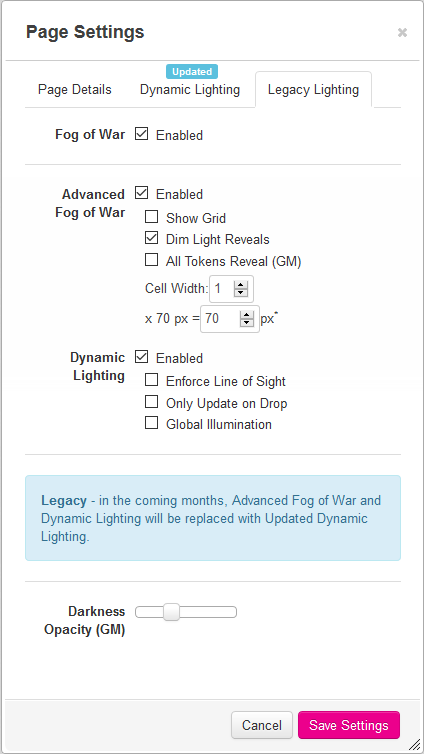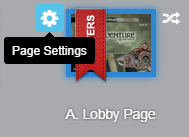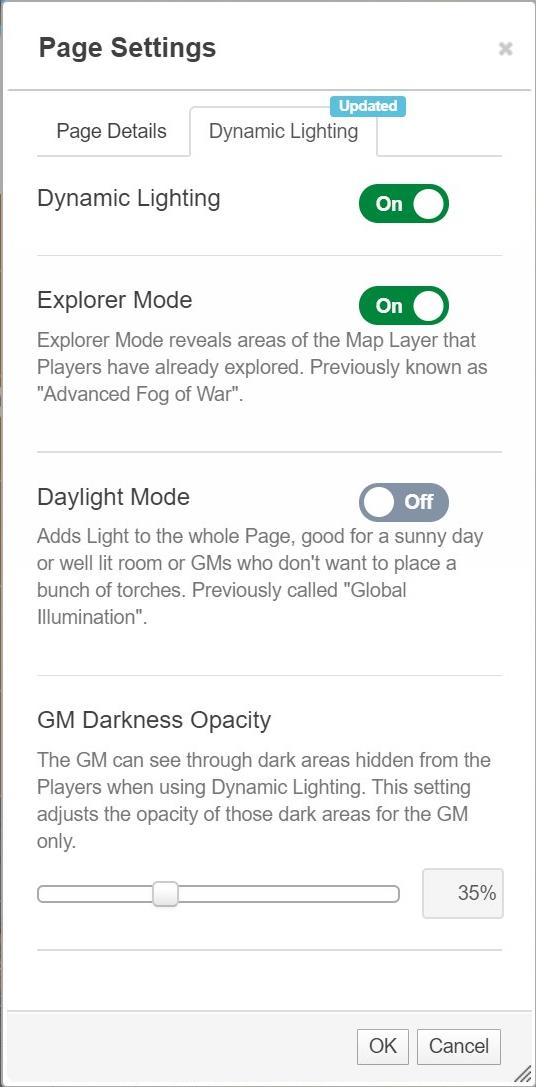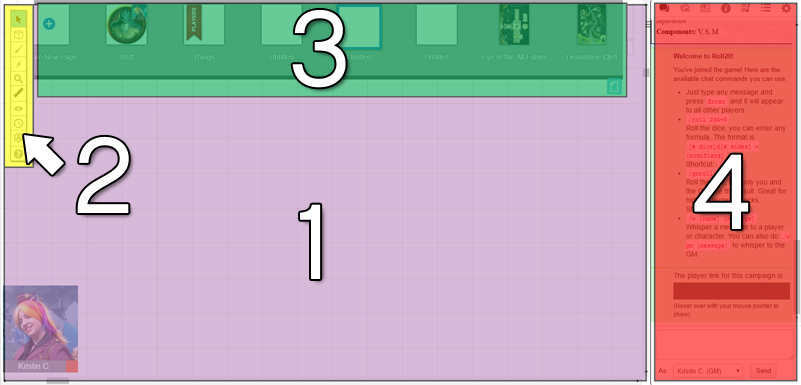Page Settings
From Roll20 Wiki
Page Updated: 2022-03-22 |
Attention: This page is community-maintained. For the official Roll20 version of this article, see the Help Center for assistance: Here .
| The Page Toolbar have received an update(Forum) in November 2020, so the images & info here is somewhat outdated. The Help Center pages linked above are more up to date on this. (January 2021) |
| This Tool is only available for GMs in a game. |
Main Page: Page Toolbar

Contents[hide] |
Pages Details
See Page Toolbar for more information about manipulating Page positions and which page the group of players or specific players are on.
There are a number of page specific settings that can be set for each page on your map. To access them, click the page button located on the top right hand corner of your map. To edit the settings for a specific page, click the gear icon next to the page you'd like to edit.
You will be presented with the Page Settings dialogue.
NOTE: The default page settings for new pages can also be set in the Campaign Settings page. All of the below options, except Play on Load, can be configured in the default page settings.
Page Size
The size of the page canvas can be adjusted here, by changing the width and height values. You can set these in increments of 70 pixels, or put the total pixels of your canvas and Roll20 will convert it for you.
NOTE: Roll20 uses a baseline of 70 pixels equals 1 inch, when displayed at 100%. While different monitors, browsers, and zoom levels display a different number of actual pixels per inch, this is the baseline measurement used in the platform for the Page Settings measurements.
Background
Using the Background Color palette, you can select a fill color for the entire map. Click on the color swatch (white box by default) which will pull up the color chooser. From there, you can either select the color you'd like from the palette, or, for advanced users, enter a specific hexadecimal color code. (For a list of colors, try Colorpicker.com).
Page Scale
Page Scale allows you to choose what a single grid cell represents, in both size and units of measurement. For the size, the default is 5 ft-- every 70 pixels represents 5 feet of distance. If the grid is disabled, the Page Scale sets how much distance is represented by every 70 pixels on the canvas (at 100% scale).
For the units of measurement, choose between ft, m, km and mi and select how many of that unit each square is worth. You can also select a custom measurement.
Grid
There are a number of different grid options to choose from, including size of the grid, how diagonal distance is measured, the type of grid (square, horizontal hex and vertical hex), (D&D 5e/4e, 3.5/Pathfinder, Euclidean, Manhattan, Hex Grid), whether or not to display labels in the cells (hex grids only) and the color and opacity of the grid. Read more about the Ruler and measurements here.
To enable or disable the grid, simply select the Enabled checkbox. If it's checked, the grid is on, unchecked and the grid is completely off.
Note: disabling the grid will also disable any grid snapping effects, since there's nothing for the objects to snap to.
The grid can also be made smaller or larger by adjusting the grid cell size. For example, if I entered 0.5 into the Cell Width (or Cell Height, for Hex (H) grids), the canvas will draw lines twice as often as by default, making each cell 35 pixels across. Likewise, a size of 2 would double the size of each grid cell. You can enter a number as either a multiplier or in pixels. The Page Settings dialog box automatically converts between cell size and pixels.
Just like the background color, you can also select what color you'd like your grid lines to be. By clicking on the color selection box, you'll be presented with a palette where you can either select a color, or enter a custom hex code.
If you'd like to make your grid lines darker or lighter, you can adjust the opacity using the grid opacity slider. This slider will make the grid more, or less transparent, so you can make it fade into the background, or boldly stand out. Simply slide it to the left to make the lines more transparent, or to the right to make them more opaque. If you slide the bar all the way to the left, your lines will become invisible. This is handy if you still want the snap to grid feature, but don't want to see the lines.
Fog of War
Main Page: Fog of War
If you'd like to use the Fog of War feature, you must first enable it for the page. To do so, select the "Enabled" checkbox. This will turn it on for the page, and cover the entire map in fog.
GM Opacity
The fog appears as a solid black area to players, but for the GM it's a semi-transparent layer. If you'd like to adjust how dark the fog appears to you (handy for dark maps where it's hard to tell where it is) use the "GM Opacity" slider to adjust how transparent or opaque it appears. Simply slide the slider to the left to make the fog lighter, or to the right to make it darker. If the slider is all the way to the left, the fog will be completely invisible, and if it's all the way right, it will be completely solid.
Play on Load
Choose a u Jukebox track or Playlist which will automatically play when you move the players to the page. Note that this only takes effect when a GM moves the Player Ribbon to the page, not for the Split the Party-feature (since the Jukebox is global, not player-specific).
Archive Page
Main Page: Archiving
You can archive any page to hide it from the page selection. Archived Pages will appear at the far right end of the Page Toolbar, from there, they can be restored at any time.
Archiving can be helpful if you have a large number of pages and want to make navigation easier. Move the Players Ribbon to the next page, and then archive the page you moved from.
| Archived Pages still loads at game startup time, and does not improve game performance. Pro info users have the option of using the Transmogrifier to store unused Pages in a separate game. See Library Campaign for more details. |
Delete Page
Clicking this button will permanently delete the current page from the Page Toolbar.
Note: You will not be able to delete the page if the Player Ribbon is currently placed upon it or if it's the page that is currently being viewed on the tabletop.
Duplication of Page Settings
Check out the Page Toolbar.
Dynamic Lighting
| This section is about a Roll20 feature exclusive to Plus & Pro-subscribers, or to players in a Game created by a Plus/Pro-subscriber. If you'd like to use this feature, consider upgrading your account. |
Main Page: Updated Dynamic Lighting
The Dynamic Lighting manages the options for the Updated Dynamic Lighting. See UDL Page Settings on the Roll20 Help Center or Updated Dynamic Lighting-page for more info.
- Restrict Movement prevents tokens with vision from passing through vision obstructing obstacles.
- Global Illumination allows tokens with vision to see everything so long as there are not vision obstructing obstacles blocking their way.
Dynamic Lighting (Legacy)
| This section is about a Roll20 feature exclusive to Plus & Pro-subscribers, or to players in a Game created by a Plus/Pro-subscriber. If you'd like to use this feature, consider upgrading your account. |
| LDL together with Advanced Fog of War will eventually be discontinued. More info: Legacy Sunset Plans(Blog) |
If you'd like to use the Legacy Dynamic Lighting feature, you must first enable it for the page. To do so, select the "Enabled" checkbox. You can use Fog of War In combination with Legacy Dynamic Lighting, and one is not dependent on the other to function.
If you or your players suffer from sluggish dynamic lighting render results you might want to consider checking the option "Only Update on Drop". This option only redraws the dynamic lighting after a token has been picked up and placed elsewhere on the map. This can lessen the render burden for users running on slower connection speeds or when a GM is working with a very large or complex map.
Enforce Line of Sight will allow you to set specific line of sight parameters for tokens. Restrict Movement prevents tokens with vision from passing through vision obstructing obstacles. Global Illumination allows tokens with vision to see everything so long as there are not vision obstructing obstacles blocking their way.
For more information on Line of Sight and Dynamic Lighting, check out the Token Features and Legacy Dynamic Lighting help guides.
Advanced Fog of War is a feature for Legacy Dynamic Lighting.
Related pages
- Interface
- 1. The Tabletop
- 2. The Toolbox
- 3. Page Toolbar
- Page Settings
- 4. The Sidebar














